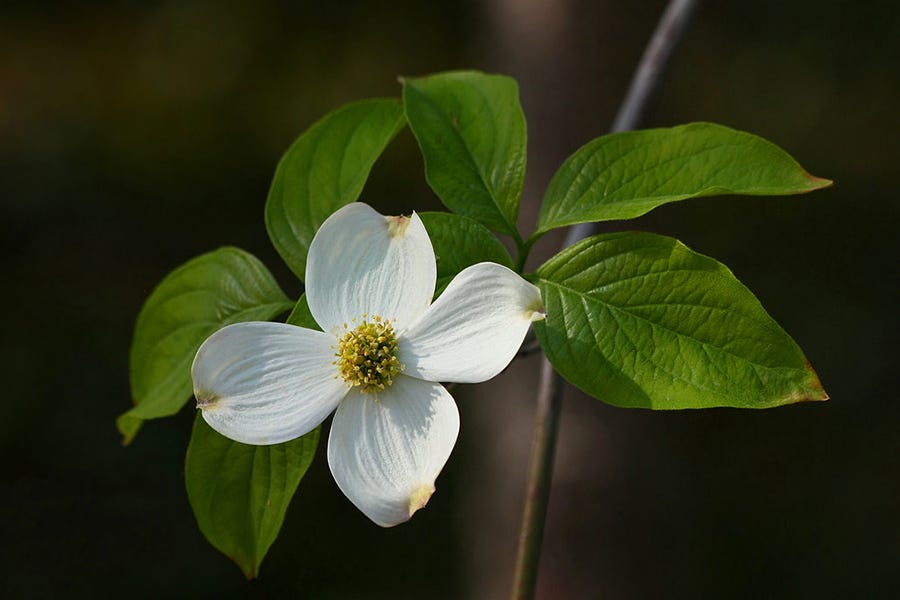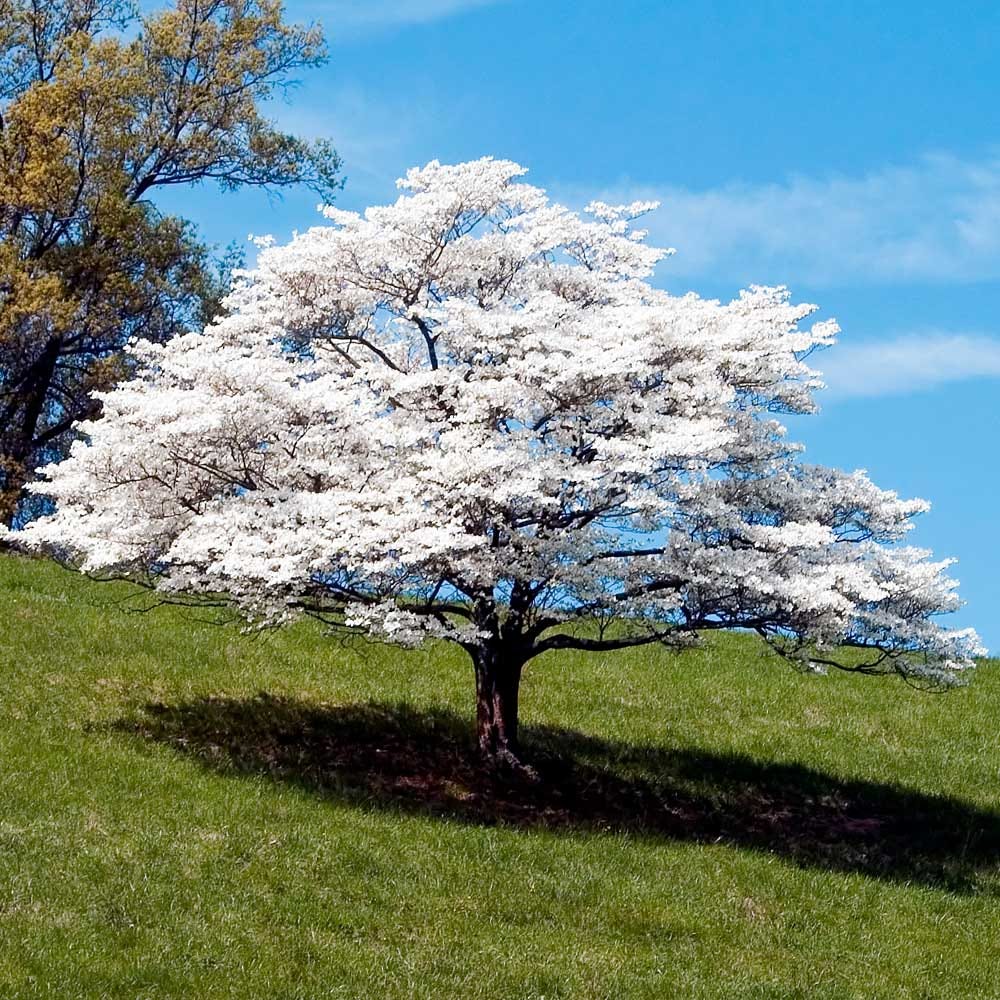This will be the first in a slew of weekly posts I will craft this summer about how to identify the natural world, or at least how I learn the names and build relationships with the beings around me. Every week, my goal is to sit with a tree, a plant, a bird, a being, and go through the process of identifying it. Practically, it will be some advice on how to familiarize yourself with the names of the library of life, less practically it will be musings on how I connect with the land through close observation.
Maybe at the beginning there will be a brief update or recommendation or notable life thing. Just as a practice of openness that can slip deeper into my writing. But the main focus will be on how to build relationships with the world. I hope that in reading, you learn that you can create connection and something like a mutual understanding with the world by paying a little extra attention.
I’d figured I’d start with the flowering dogwood (Cornus florida), the state tree of Virginia and one of the first trees I could identify, but I’m finding it hard to say anything about it with the state of the world.
How can I talk about this spindly, delicate being and tell you about its branching patterns and natural history and my little childhood anecdotes while wars erupt around the globe, and the gestapo-like I.C.E. rips apart families here in the US? What am I even doing, focusing on a little tree with soft pink or white flowers that coated my driveway in springtime? F35’s buzz my house in Burlington on early morning strafing runs, and humvees rumble down Vermont’s country roads, and bombs drop all over the world, why does it matter if you or I care or know about the beautiful, fragile, delicate dogwood?
I don’t know. And I don’t have much in the way of an answer. My feeling is that dogwoods are beauty. They are fragility and the preciousness of life embodied in a tree. In the face of the never ending wild fight for life where the tree could become thick and tall and burly and emotionless, it makes graceful slopes of branches and symmetrical leaves and velvet flowers. In the face of war, it makes art.
To closely study the tree is to witness our one wild and precious life and to remember every person’s beauty and fragility. So hopefully, I can help you find a dogwood so we can all fight for natural human tenderness together.
—
Now, how do you know if you are looking at a flowering dogwood, or any type of tree for that matter. My process for identifying or saying hello to any tree or being has three parts: vibe, then its most identifiable features, then context. The vibe is based on the general shape and look of a tree. Is it tall? How many stems does it have,? Is it a broadleafed tree, like dogwoods and maples, or is it coniferous, like white pine and balsam fir? Does it feel like a grandfather? Does it seem melancholly? All of these things can help you narrow down what kind of tree or being you are looking at, especially as you have a greater understanding of the library of life.
Vibe
Basically, step one is: what big categories does this fall into?
Dogwoods - Trees found from Florida to Maine, medium sized, deciduous, feels like an older sister.
Specific Identifiable Features
Next is the specific, differentiating features within the broad categories. For the dogwood, a broadleaf, small, delicate tree, that means starting at the leaves and twigs.
You can tell a lot from just the end of a branch. A tree introduces itself with its leaves and branching pattern like an arm outstretched for a handshake. The leaves of a dogwood are simple, meaning that one leaf looks like one leaf. Simple. As opposed to one leaf looking like multiple leaves (compound). They are oval shaped with smooth edges.
When you hold a leaf up to the light, you can see its veins — the capillary system we borrowed from the plants millennia ago. The venation of a leaf can also help you identify it. Dogwood leaves have arcuate veins, meaning that the veins of the leaf look like a tree. The shape of the larger reflected in the face of the smaller. There is one center line with branches coming off opposite of each other and arcing towards the end of the leaf.
Opposite can also be used to describe the branching pattern of dogwoods. In opposite branching patterns, each branch has a partner mirrored on the opposite side. The pattern is reflected in the branches and in the veins of the leaves.
The flowers of a dogwood are striking. In spring, a tree might be entirely white or pink. The flowers are actually the little yellow circles surrounded by the white bracts. Bracts are leaves that are made to look enticing, like flower petals. A dogwood’s flowers (and bracts) are symmetrical with four lobes arranged facing up and out to the world, inviting pollinators, rain, and the occasional nose.
Now you can learn all of that about branching, leaf shapes, and flowers, but in the end, it is about memorizing what the leaf looks like, and spending enough time and attention to the tree to start to understand how it presents itself. In fact, each tree might look different and each leaf my be a different size and shape. That is why vibe and a collection of general identifiers are key. I almost never rely on a single distinguishing feature to identify anything.
In general the distinguishing features of a dogwood are:
opposite branching,
thin and delicate trunks,
pink or white flowers in the spring,
red or purple leaves in the fall,
smooth oval shaped leaves with veins that arc out and toward the tip, and
Remember, if it gives you the sweet warm inspiration of an older sister, I think you’ve found a dogwood.
Again, I can show you all the pictures in the world and describe what a dogwood looks like, but the only way to be able to recognize one, is through intentional conversation and observation. Like all relationships, it has to build over time. You have to see the tree, and notice it, greet it, feel the leaf texture, remember how the bark smells, look for the opposite branches, and say its name. Make up a similarity you have with it. Let it tell you a story. Only then, through repetition, attention, and connection will your mutual understanding blossom into a unique symmetrical flower.
Context
The third step for me, when identifying a tree, is considering the context. This isn’t necessary all the time (although sometimes it’s very important), but it’s always helpful for understanding it. Considering the context means thinking about where you are geographically, what are the other plants around, and where you are in the landscape. This can sometimes be the deciding factor between two similar trees. Some trees can have nearly identical bark and leaves and branches but live in different elevations or habitats.
In conversation with a tree we go from broad (vibes), into very narrow and granular (distinguishing features), and back out into broad (context). Its the same arc as when you meet new people starting with small talk, making specific connections, then broadening out into bigger topics.
In end, the context for a tree can be variable and complex talking about politics, family dynamics, opinions on how to raise children, shade tolerance, phenology, and its natural history. This is how I would contextualize the dogwoods in my parents’ yard.
The tree is small and its trunks are thin. The one next to my childhood driveway was no more than 12 feet tall. The crown is wider than that, maybe 20 feet in total. This is normal for a dogwood. The one in my backyard on the other-hand is a towering tree, maybe 40 feet tall. But its dwarfed by the red oak that is there in my memory that was over 100 ft tall and five feet thick. This is also normal for a dogwood. They are mostly large bushes, providing some extra square footage in the mid-story of the forest. Not the floor, not the canopy, but adding to woods height complexity somewhere in the middle.
The height makes it perfect for bird nests and something called refugia (a place to hide and take refuge) for birds and smaller mammals. It also is a perfect height for a young Arlingtonian to make a ramshackle treehouse with his dad for his own slice of refugia. All that was needed were three pieces of 2 x 4, two slices of plywood, probably 16 nails, and the opening arms of a dogwood’s splaying trunks. There, birds and boys can look out at the world from behind the opposite, simple leaves, and showy white flowers.
I’m not sure birds sit up amongst the branches imagining fighting off the British during the revolutionary war or dreaming that their imaginary friend Perry the peregrine falcon is there with them changing shapes from boy to bird and back. But I think me and the cat birds get a lot of the same feelings of safety from within the dogwood.
Dogwood seeds are also eaten by a slew of mammals and birds alike (songbirds, foxes, chipmunks, and even bears). I didn’t realize as a kid, but the deer that came to our suburban backyard were probably drawn in by the dogwoods before demolishing my moms’ azaleas.
These dogwoods were likely planted, but whoever planted them put them in the right spots under a few larger trees giving them dappled shade and room to grow.
The bottom line is that the dogwood is a beautiful being that I feel honored to be in the presence of. It shows strength in its delicateness and it shares itself with the world providing beauty, food, shade, and shelter for birds and boys still figuring out how to be.







